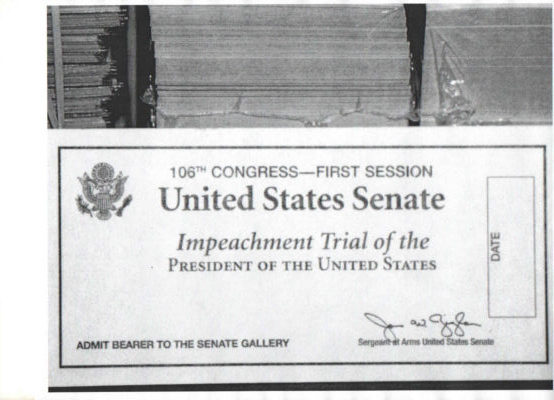Much of the attention on House Resolution 660 to advance the impeachment of the President has failed to note the significant differences from resolutions authorizing previous presidential impeachments. Previous resolutions authorized those impeachment inquiries at the outset.
This one simply says “carry on” to committees that began investigating weeks ago. That is something new and different. You can decide for yourself the value of precedent.
Fair or Unfair
Previous resolutions authorized only the Judiciary Committee to investigate. They were given the responsibility to determine whether impeachment grounds exist. On Sept. 24, House Speaker Nancy Pelosi unilaterally told six different committees to investigate without any rules or procedures. That is something new and different. Please decide for yourself the value of precedent.
HR 660 sets procedures for public hearings. But it does so in only two of the six investigating committees. The others are named in the resolution. They are told simply to “continue their ongoing investigations as part of the existing House of Representatives inquiry.” This seems to mean the other four committees will continue operating in secret. It also means they will continue using procedures they make up as they go along. That is something new and different. You can decide for yourself the value of precedent.
The House resolution creates a structure for subpoena authority in the Intelligence and Judiciary committees. The question is: Why is the structure very different from what was in place for the Clinton and Nixon impeachments. That is something new and different. You can decide for yourself the value of precedent.
In the Clinton impeachment, on Oct. 8, 1998, the House adopted HR 581.
Partisan or balanced
The resolution was granting subpoena authority to “the chairman and ranking member acting jointly.” If “either declines to act,” the other may act alone after bringing the matter to the committee to decide “whether such authority shall be so exercised.” HR 803, adopted on Feb. 6, 1974, included the same provision for the Nixon impeachment. That provision for subpoena authority is missing. That is something new and different. You can decide for yourself the value of precedent.
The structure for subpoena authority in HR 660 is the opposite. It is not directed to both the majority and minority. It does not use the word “jointly” at all. Instead, the ranking minority member must have “the concurrence of the chair” to exercise subpoena authority, but not vice versa. If “the chair declines to concur,” the ranking minority member must bring the matter to the committee for decision. That is something new and different. You can decide for yourself the value of precedent.
In other words, the chairman can act unilaterally, while the minority always needs the majority’s permission. Democrats’ favorite word is fair. Is what they are doing fair? We know it is different than the procedures previously employed. Why is their new procedure more fair? Or maybe the question is what do you think of Democrat fairness? What’s new in the impeachment procedures?
New secret proceedings without objective standards
HR 581 from 1998 explicitly said; after committee approval, the ranking minority member can exercise subpoena authority “acting alone.” HR 660 deletes any mention of the ranking minority member actually exercising subpoena power. Instead it says only that he or she may refer the matter to the committee. That is something new and different. You can decide for yourself the value of precedent.
There are more radical developments brewing in individual committees. HR 660 presents the Intelligence Committee as taking the lead. The Judiciary Committee has made its own move. Chairman Jerry Nadler has released the committee’s own impeachment hearing procedures “pursuant to House Resolution 660.” These procedures appear to allow Trump’s counsel to attend and participate in any Judiciary Committee hearings. But there’s a caveat.
Section F states Nadler can impose “appropriate remedies” if the president “unlawfully” refuses to make witnesses available or to produce requested documents for any of the six investigating committees. These remedies include “denying specific requests by the President or his counsel under these procedures to call or question witnesses.” Remember that four of the six House investigating committees can continue operating in secret. They will operate under whatever rules or procedures they choose. That investigative scheme, in fact, can be entirely different for each of those committees. That is something new and different. You can decide for yourself the value of precedent.
Co-equal branches of government… Separation of powers
Nadler claims the ability to determine when the president has acted “unlawfully” in relation to committees over which he has no authority. That is actually legally incorrect. The executive branch is a co-equal branch of government. This is not a petty parsing this is a question of separation of powers.
When he does, based on whatever arbitrary and capricious standards or criteria he alone chooses, Nadler says he can bar the president, the impeachment defendant, from participating at all in the Judiciary Committee’s hearings. Does that seem fair to you? That is something new and different. You can decide for yourself the value of precedent.
Thankfully, the Constitution’s impeachment provisions have not been used often in American history. But we do know how to conduct a presidential impeachment that is genuinely fair, legitimate, and that minimizes partisanship. The attempt has been made 8 times. House Democrats have chosen this time to reject the example, counsel, and guidance of that experience and opted instead for a glaringly partisan, unbalanced, unfair and novel process. What’s new in the impeachment procedures?
